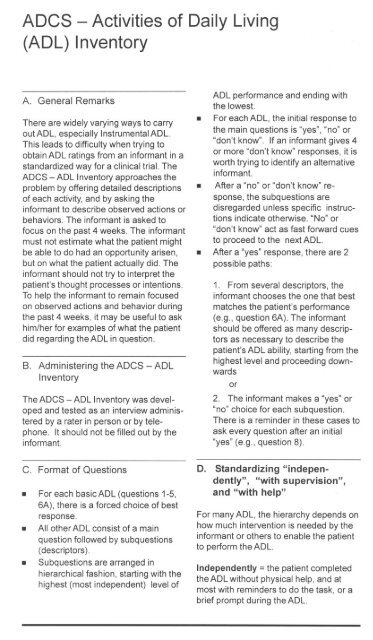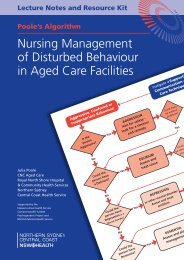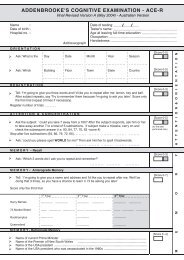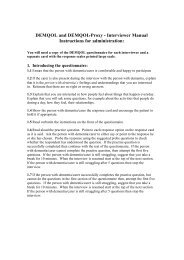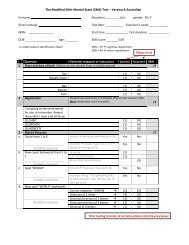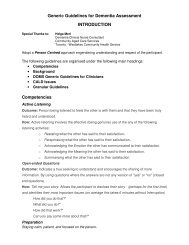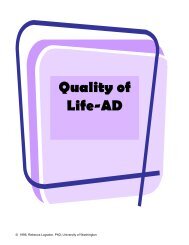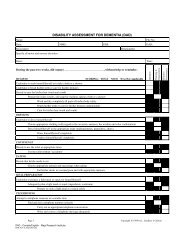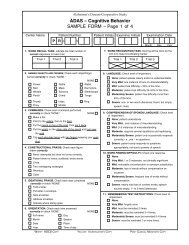ADCS-ADL Scale, Scoring and Manual - Dementia Outcomes ...
ADCS-ADL Scale, Scoring and Manual - Dementia Outcomes ...
ADCS-ADL Scale, Scoring and Manual - Dementia Outcomes ...
Create successful ePaper yourself
Turn your PDF publications into a flip-book with our unique Google optimized e-Paper software.
<strong>ADCS</strong> - Activitiesof Daily Living<br />
(<strong>ADL</strong>) Inventory<br />
A. General Remarks<br />
There are widely varying ways to carry<br />
out <strong>ADL</strong>, especially Instrumental <strong>ADL</strong>.<br />
This leads to difficulty when trying to<br />
obtain <strong>ADL</strong> ratings from an informant in a<br />
st<strong>and</strong>ardized way for a clinical trial. The<br />
<strong>ADCS</strong> - <strong>ADL</strong> Inventory approaches the<br />
problem by offering detailed descriptions<br />
of each activity, <strong>and</strong> by asking the<br />
informant to describe observed actions or<br />
behaviors. The informant is asked to<br />
focus on the past 4 weeks. The informant<br />
must not estimate what the patient might<br />
be able to do had an opportunity arisen,<br />
but on what the patient actually did. The<br />
informant should not try to interpret the<br />
patient's thought processes or intentions.<br />
To help the informant to remain focused<br />
on observed actions <strong>and</strong> behavior during<br />
the past 4 weeks, it may be useful to ask<br />
him/her for examples of what the patient<br />
did regarding the <strong>ADL</strong> in question.<br />
B. Administering the <strong>ADCS</strong> - <strong>ADL</strong><br />
Inventory<br />
The <strong>ADCS</strong> - <strong>ADL</strong> Inventory was developed<br />
<strong>and</strong> tested as an interview administered<br />
by a rater in person or by telephone.<br />
It should not be filled out by the<br />
informant.<br />
C. Format of Questions<br />
. For each basic<strong>ADL</strong> (questions 1-5,<br />
6A), there is a forced choice of best<br />
response.<br />
. All other <strong>ADL</strong> consist of a main<br />
.<br />
question followed by subquestions<br />
(descriptors) .<br />
Subquestions are arranged in<br />
hierarchical fashion, starting with the<br />
highest (most independent) level of<br />
.<br />
.<br />
.<br />
<strong>ADL</strong> performance <strong>and</strong> ending with<br />
the lowest.<br />
For each <strong>ADL</strong>, the initial response to<br />
the main questions is "yes", "no" or<br />
"don't know". If an informant gives 4<br />
or more "don't know" responses, it is<br />
worth trying to identify an alternative<br />
informant.<br />
After a "no" or "don't know" response,<br />
the subquestions are<br />
disregarded unless specific instructions<br />
indicate otherwise. "No" or<br />
"don't know" act as fast forward cues<br />
to proceed to the next <strong>ADL</strong>.<br />
After a "yes" response, there are 2<br />
possible paths:<br />
1. From several descriptors, the<br />
informant chooses the one that best<br />
matches the patient's performance<br />
(e.g., question 6A). The informant<br />
should be offered as many descriptors<br />
as necessary to describe the<br />
patient's <strong>ADL</strong> ability, starting from the<br />
highest level <strong>and</strong> proceeding downwards<br />
or<br />
2. The informant makes a "yes" or<br />
"no" choice for each subquestion.<br />
There is a reminder in these cases to<br />
ask every question after an initial<br />
"yes" (e.g., question 8).<br />
D. St<strong>and</strong>ardizing "independently",<br />
"with supervision",<br />
<strong>and</strong> "with help"<br />
For many <strong>ADL</strong>, the hierarchy depends on<br />
how much intervention is needed by the<br />
informant or others to enable the patient<br />
to perform the <strong>ADL</strong>.<br />
Independently = the patient completed<br />
the <strong>ADL</strong> without physical help, <strong>and</strong> at<br />
most with reminders to do the task, or a<br />
brief prompt during the <strong>ADL</strong>.


